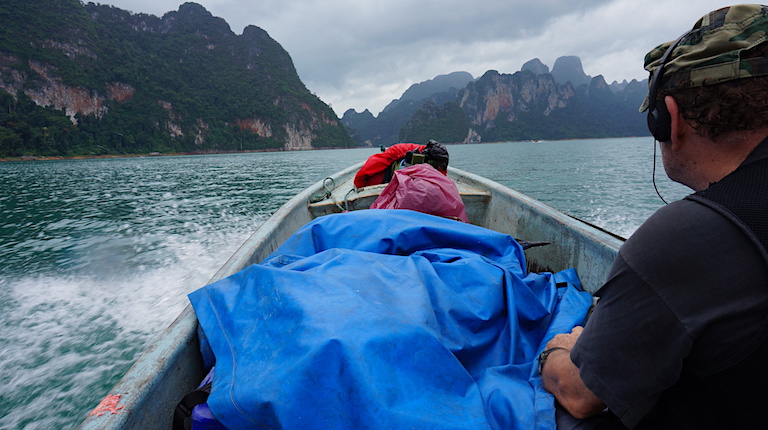- The conservation world has lost a top wildlife photographer—Lawrence “Bruce” Kekule—an American who had lived in Thailand since 1964.
- Beside documenting the rare creatures of his adopted home, Bruce also traveled abroad to favorite destinations like India: wherever he went, he raised awareness about the plight of endangered species via photography.
- This post is a commentary. The views expressed are those of the author, not necessarily Mongabay.
In June, the world lost one of its legendary wildlife photographers—Lawrence “Bruce” Kekule, an American who had lived in Thailand since 1964.
Born in 1945 in Sacramento, California, Bruce’s family would move to Hawaii and Hong Kong, where he graduated from King George V. School before he settled into Thailand for good with his father at age 19. He worked a variety of jobs, including on an oil rig where he lost a thumb in an accident off Taiwan’s southern coast, but wildlife photography was his great passion, and he devoted the last several decades of his life almost exclusively to this pursuit.
I first met Bruce in Bangkok in 2013, where we plotted a camera-trapping project in Khlong Seang Wildlife Sanctuary in Surat Thani province of southern Thailand, the results of which were covered by Mongabay. At the time, Bruce had already published several books on Thailand’s wildlife, and had kept up his own website with regular updates on his findings in places like the vast Western Forest Complex, the national parks outside of Chiang Mai, and also down south in Khlong Seang, where we worked together for a short time.

In 2014 we drove from Bangkok to Surat Thani, and along the way he confided that he now spoke Thai better than he did English, and it was with great surprise that he carried a pistol in his glove compartment, being one of the few foreign nationals to have an open carry permit for the weapon: he claimed that he would shoot any armed poacher who crossed one of his camouflaged photo-blinds. He was so absorbed in his photography that he had only discovered the band AC/DC in 2010, being cut off from popular western culture.
His efforts bore tremendous results, with the now critically endangered common leopard (Panthera pardus) and Indochinese tiger (Panthera tigris tigris) walking directly up to his blinds, where he sweated as he carefully snapped away, capturing their magnificence, before they stalked off.
It was a good thing that he carried the gun, for one time a huge gaur confronted him on a forest path in Huai Kai Khaeng Wildlife Sanctuary—one of the final strongholds for both the Indochinese tiger and leopard—and it charged him. Bruce said that he quickly recalled an excerpt from an old book, which stated that if charged by an angry gaur one should drop to the ground and let it leap over you. With great acuity, he hit the dirt, and the massive animal leapt over him. However, the great bovine soon did a U-turn, and threatened another charge. Bruce quickly pulled out his handgun and fired it into the air, spurring the gaur to reconsider; it stormed off into the forest instead.
In Surat Thani we rented a boat, stocked up with food, a huge ice block, and beer, and set off into one of the most remote corners of the Cheow Lan Reservoir which forms part of the border of Khao Sok National Park and Khlong Saeng — by far the oldest rainforest on Earth. We set off into a world of limestone crags that erupted out of the serene lake, a dreamy jungle-draped landscape swarming with rare, hidden creatures.
We were hoping to camera-trap the common leopard in Khlong Saeng, but sadly, it is either locally extinct there or reduced to such low numbers that we never found them. We did, however, capture Malayan tapir, clouded leopard, golden cat, marbled cat, gaur, Asian elephant (in one video a member of the herd stood behind our camera trap, and used the liquid in its trunk to stick leaves onto the lens to thwart our efforts to document them, see below), the great argus pheasant, and many more enigmatic species.

Bruce was passionate and at times fiery and stubborn in his ways. I can clearly recall him berating our Thai rangers for stopping to pick leeches off their legs: “This is an Asian tropical forest! What did you expect to find here? You don’t stop every five minutes to remove them! Just let them suck your blood and drop off! They’ll drop off by themselves! You don’t need to do anything and you’re wasting our time!!!”
But Bruce was also a good friend and was very supportive and encouraging of my own conservation initiatives in Cambodia’s Virachey National Park.
India was also one of Bruce’s most beloved places. He visited the country repeatedly, lugging his heavy optics, returning with great photographic captures of the Indian one-horned rhinoceros, Bengal tiger, and the extremely rare Asiatic lion (Panthera leo leo), which once roamed across vast portions of the subcontinent, but is now found only in an isolated area of western India.
No matter where he worked, Bruce did his best to raise awareness about the plight of endangered species and their habitats, and he did so lucidly with his photography. He is survived by his wife Noi and their daughter Marguerite. His work will live on forever and continue to inspire conservationists.
Greg McCann is a biologist and assistant professor at Taiwan’s Chang Gung University. He also works with a People Resources and Conservation Foundation team which is documenting the biological richness of Sumatra, so that it can be better conserved.
Banner image: L. Bruce Kekule in his element in the Khlong Saeng Wildlife Sanctuary rainforest in southern Thailand. Image courtesy of Greg McCann.
Related audio from Mongabay’s podcast: Hear this writer discuss his wildlife work via Mongabay’s podcast series about Sumatra, listen here:

